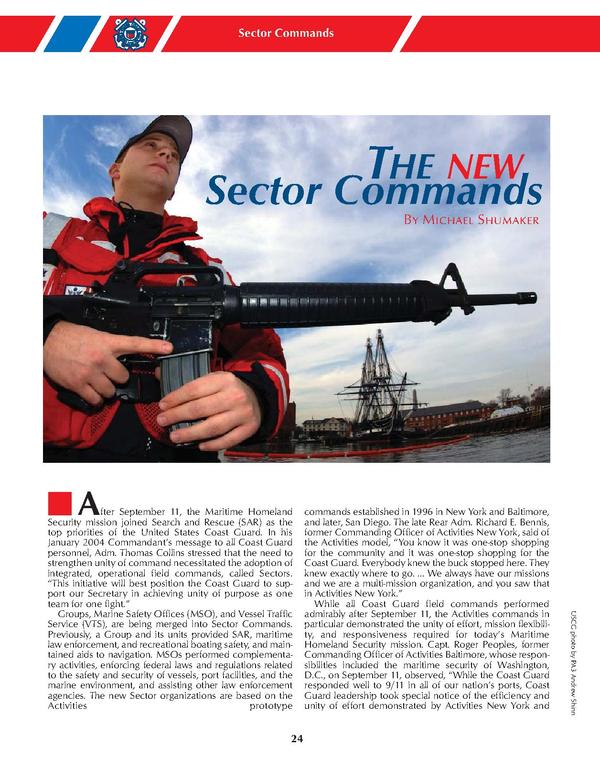Organization

The Sector organizational construct represents a transformation from a Coast Guard traditionally organized around its operational programs to one organized around core operational service delivery processes. It focuses the coordinated efforts of all assigned operational capabilities to accomplish Coast Guard mission objectives.
Sector Commander
The commanding officer of a Sector is called the Sector Commander and is usually the rank of Captain. The Sector Commander holds the positions of Captain of the Port (COTP) and Federal Maritime Security Coordinator (FMSC). Unless otherwise assigned, the Sector Commander is also the Officer in Charge Marine Inspections (OCMI), Search and Rescue Mission Coordinator (SMC), and Federal On-Scene Coordinator (FOSC). The Sector Commander reports to the appropriate District Commander.
Command Staff
The Sector Commander's second-in-command is the Deputy Sector Commander. Also reporting directly to the Sector Commander are the:
- Command Master Chief (CMC)
- Senior Reserve Officer
- Auxiliary Coordinator
Command Center
The Sector Command Center (SCC) is the center of Sector Operations. It provides 24-hour command, control, coordination, communications, intelligence, sensor analysis, and data mining (C4ISM). The SCC coordinates with other federal, state, and local operations centers, and issues Notices to Mariners, Situation Reports, and maritime security alerts. The SCC displays the current Common Operating Picture (COP) and Common Intelligence Picture (CIP), including a presentation of all vessels, aircraft, communications equipment, and personnel belonging to the Coast Guard and supporting agencies.
Contingency Planning and Force Preparedness
The Contingency Planning and Force Readiness Staff develops and maintains plans covering readiness, logistics, and emergency preparedness. It coordinates with the three departments in plan development and execution, and plans and executes readiness exercises to test contingency plans. The Contingency branch also monitors the training and readiness of Sector Reserve Forces and manages their mobilization and demobilization. The Contingency Planning and Force Readiness staff also manages the federally mandated Area and Area Maritime Security Committees around the nation.
Intel
The Intelligence Staff is envisioned to collect, evaluate, report, and disseminate operational intelligence within the Sector. This staff will serve as the primary intelligence support element for all operations within the Sector. This staff forwards its analysis of raw intelligence reports to the District and the Atlantic or Pacific Maritime Intelligence Fusion Center, and will be the critical link between the Sector Commander and the entire Coast Guard intelligence enterprise, which is in turn a part of the United States Intelligence Community.
Response
The Response Department contains two Divisions:
- Incident Management Division: Addresses unit search & rescue policy, pollution response, and all-hazards incident management.
- Enforcement Division: Provides administration and oversight to the Coast Guard Boat Stations and Cutters that enforce U.S. law and execute the service's Ports, Waterways & Coastal Security (PWCS) enforcement activities, such as armed boardings, vessel escorts and security zone enforcement. This division works closely with federal, state, and local law enforcement and sister agencies within the DHS to respond to and mitigate the impact of maritime threats.
Prevention
The Prevention Department consists of three divisions.
- Inspections Division: Manages and oversees the regulatory and inspection aspects of the Coast Guard’s safety, security, and environmental protection responsibilities for vessels and facilities.
- Waterways Management Division: Controls aids to navigation; safety and security zones; Regulated Navigation Areas; ice breaking; and VTS and AIS.
- Investigations Division: Initiates inquiries into marine casualties, pollution, boating violations, and assessment of civil penalties.
Logistics
The Logistics Department performs unit level maintenance and organic engineering, personnel, medical support, and finance/supply functions for the entire Sector.
- Engineering/Support Division: Administers electronics and computer system, naval, aviation, vehicle, and facilities engineering; armory and small arms qualification; and environmental compliance. The associated Integrated Support Command or Aircraft Repair and Supply Center handle intermediate and depot level maintenance.
- Administrative/Personnel Division: Handles medical, training, housing, and educational services.
- Finance/Supply Division: Encompasses galley, transportation, and property and inventory management.











